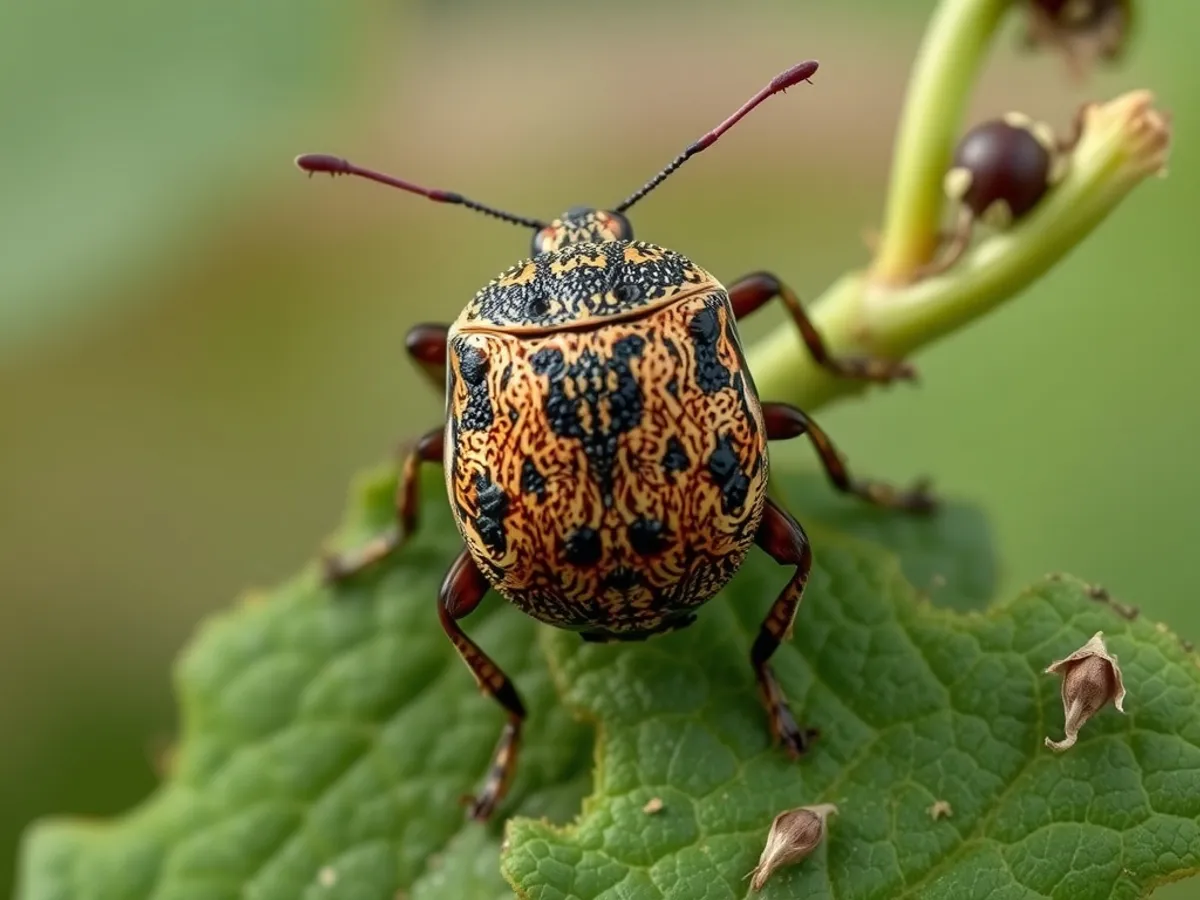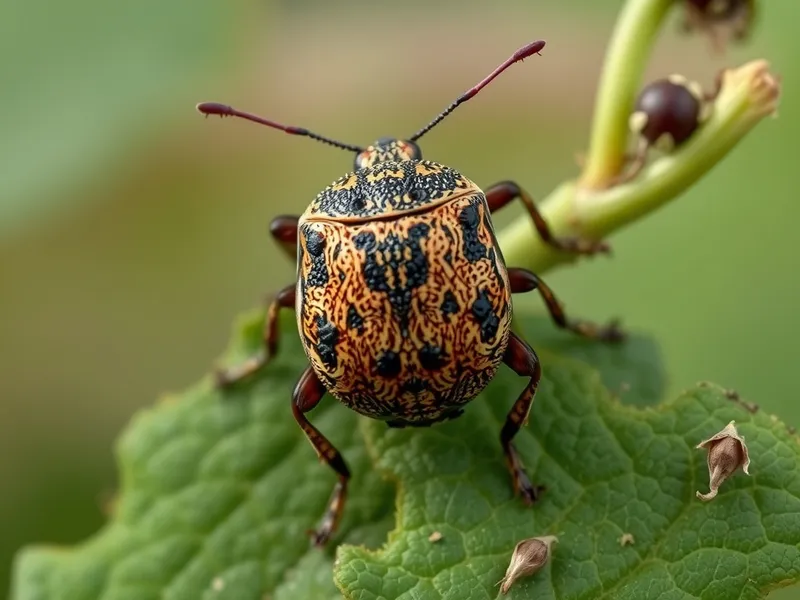
Brown marmorated stink bug
Halyomorpha halys

Meet the Brown marmorated stink bug
The brown marmorated stink bug is an invasive insect species originally native to East Asia, particularly China, Japan, and Korea. Recognizable by its shield-shaped body and mottled brown coloration, this bug emits a pungent odor when threatened or crushed, which serves as a defense mechanism against predators. It is considered a significant agricultural pest, feeding on a wide variety of fruits, vegetables, and ornamental plants, causing extensive crop damage. Since its accidental introduction to North America and Europe, the brown marmorated stink bug has rapidly spread, adapting well to both urban and rural environments.
Classification
Invertebrate
Habitat
Forests, agricultural fields, gardens, and human dwellings
Diet
Herbivore
Lifespan
6-8 months
Conservation
Least Concern
Weight
0.1-0.2 grams
📖Fascinating Facts
Shield Shape
The brown marmorated stink bug has a shield-shaped body typical of the Pentatomidae family, aiding in its camouflage among leaves and bark.
Wide Host Range
This bug feeds on a wide range of host plants including apples, peaches, tomatoes, corn, and soybeans, causing economic losses to farmers.
Home Invader
In autumn, large groups of stink bugs can gather and enter homes through cracks and gaps, seeking warmth for overwintering.
📋Detailed Description
The brown marmorated stink bug (Halyomorpha halys) is a medium-sized true bug, typically measuring 12–17 mm in length and 7–10 mm in width. Its body is shield-shaped, with a mottled brown coloration and distinctive pale banding on the antennae and the outer edges of the abdomen (connexivum). The ventral surface is lighter, often with a coppery or metallic sheen. Adults possess well-developed scent glands on the thorax, which emit a pungent odor as a defense mechanism. The nymphs, which pass through five instar stages, are smaller and more rounded, with red and black markings that change as they mature. H. halys is a highly polyphagous species, feeding on the sap of over 100 plant species, including fruit trees, vegetables, and ornamental plants. It uses its piercing-sucking mouthparts (rostrum) to extract plant fluids, causing characteristic damage such as pitting, deformation, and premature fruit drop. The species is primarily crepuscular, with peak activity during dawn and dusk, but can be active throughout the day in favorable conditions. In temperate regions, adults overwinter in sheltered locations, including human dwellings, emerging in spring to mate and lay eggs. Their ability to aggregate in large numbers during overwintering is a notable behavioral trait, often leading to nuisance infestations in homes.
💡 Did you know?
This species can feed on over 100 different plant species, making it one of the most versatile pest insects in invaded regions.
🔬Research & Sources
Wikipedia Summary
The brown marmorated stink bug is an insect in the family Pentatomidae, native to China, Japan, Korea, and other Asian regions. In September 1998, it was collected in Allentown, Pennsylvania, where it is believed to have been accidentally introduced. The nymphs and adults of the brown marmorated stink bug feed on over 100 species of plants, including many agricultural crops, and by 2010–11 had become a season-long pest in orchards in the Eastern United States. In 2010, in the Mid-Atlantic United States, $37 million in apple crops were lost, and some stone fruit growers lost more than 90% of their crops. Since the 2010s, the bug has spread to countries such as Georgia and Turkey and caused extensive damage to hazelnut production. It is now established in many parts of North America, and has recently become established in Europe and South America.
Last Modified: 5/30/2025
🎭Behavior & Social Structure
Brown marmorated stink bugs are solitary feeders but exhibit strong aggregation behavior, especially during overwintering when they seek out warm, protected sites in large groups. Feeding occurs on a wide range of host plants, with adults and nymphs using their stylet-like mouthparts to pierce plant tissues and consume sap from fruits, seeds, leaves, and stems. They are highly mobile, capable of flying several kilometers in search of food or overwintering sites. While not aggressive, they may drop from plants or fly away when disturbed. Their daily routine involves foraging during warm daylight hours and seeking shelter during cooler periods. Communication is facilitated by chemical cues (pheromones) and vibrational signals, especially during mating and aggregation. They do not exhibit parental care, and social interactions are generally limited to aggregation and mating behaviors.
👶Reproduction & Life Cycle
Reproduction in H. halys begins in spring, shortly after adults emerge from overwintering. Mating is polygynous, with females capable of mating multiple times. Females lay clusters of 20–30 barrel-shaped, pale green eggs on the underside of leaves, producing up to 400 eggs over their lifetime. The incubation period is temperature-dependent, typically lasting 3–7 days. Nymphs undergo five instar stages over 4–6 weeks, molting between each stage. Development from egg to adult can take 35–70 days, depending on environmental conditions. In warmer regions, two or more generations may occur per year (multivoltine), while cooler climates usually support a single generation (univoltine). There is no parental care; nymphs are independent upon hatching.
🛡️Adaptations & Survival
H. halys has evolved several adaptations that contribute to its invasive success. Its cryptic coloration and shield-shaped body provide camouflage against bark and foliage, reducing predation risk. The ability to emit a pungent defensive odor deters predators such as birds and small mammals. Its highly polyphagous diet allows it to exploit a wide range of host plants, increasing its ecological flexibility. The species' strong flight capability aids in dispersal and colonization of new habitats. Physiologically, it can tolerate a broad range of temperatures, enabling survival in diverse climates. Behavioral aggregation during overwintering enhances survival by reducing individual desiccation and predation risk.
📚Research Sources
🎨Cultural Significance
In its native East Asian range, H. halys has limited cultural significance but is recognized as a minor agricultural pest. In invaded regions, it has become notorious as a household nuisance and a symbol of invasive species impacts. Its presence in homes during overwintering has led to public awareness campaigns and media coverage. There are no known traditional uses or symbolic associations, but its economic impact has influenced agricultural policy and research priorities in affected countries.
🔬Recent Research & Discoveries
Recent research has focused on biological control, particularly the introduction and establishment of the samurai wasp (Trissolcus japonicus), a natural egg parasitoid from Asia, as a sustainable management strategy. Studies have also examined the stink bug's genome, revealing genes associated with pesticide resistance and host plant selection. Ongoing research addresses the development of pheromone-based traps and attract-and-kill strategies to monitor and control populations. Climate modeling studies predict continued range expansion in Europe and the Americas. The species serves as a model for studying invasion biology and rapid adaptation in agricultural pests.
🎥Wildlife Videos

Wildlife - Just Insects | Free Documentary Nature
Wildlife - Episode 5: Just Insects | Wildlife Documentary Watch 'Wildlife - Episode 6' here: https://youtu.be/nfpzQyi9UFU Earth is ...
Free Documentary - Nature
![The Hidden Mysteries Behind The Dinosaur-Like Insects Of Amazonia | [4K] Wildlife Documentary](https://i.ytimg.com/vi/Y58UtzZNtyU/hq720.jpg?sqp=-oaymwEcCOgCEMoBSFXyq4qpAw4IARUAAIhCGAFwAcABBg==&rs=AOn4CLCLwWX1cKRfcpT6rl3C_AFpQV4GUQ)
The Hidden Mysteries Behind The Dinosaur-Like Insects Of Amazonia | [4K] Wildlife Documentary
A look at the complex relationships of the "mini monsters", insects of the Membracidae family, treehoppers that live amid one of the ...
Wild Habitat - Nature Documentaries

Masters Of Disguise: Meet The Creatures Lurking In The Wilderness | Nature Documentary
Insects use ingenious camouflage and defense mechanisms like mimicry and protective coloration to evade predators and blend ...
All Out Wildlife

A Stink Bug - Like You've Never Seen It Before | Insect close up | animal
... nature documentary explorers punk rock rockstar series video youtube deep look stink bug brown marmorated stink bug insect ...
Wild Nature & Veterinary

Smelly Stink Bug | Nat Geo Wild
About National Geographic Wild: National Geographic Wild is a place for all things animals and for animal-lovers alike. Take a ...
Nat Geo Animals

This Stink Bug's Mouth Will Melt Your Insides
Ever seen a predatory stink bug? Their spear-like mouthparts are something out of a horror movie-- right in time for Halloween!
MyWildBackyard
🌍Habitat Information
The Brown marmorated stink bug typically inhabits Forests, agricultural fields, gardens, and human dwellings environments. Brown marmorated stink bugs have adapted to their environments with specialized features and behaviors.
Primary Habitat:
Forests, agricultural fields, gardens, and human dwellings
More detailed habitat information will be available soon.
🛡️Conservation Status
The Brown marmorated stink bug is currently classified as Least Concern. Conservation efforts are crucial for preserving this species for future generations.
Common Threats:
- 🏠Habitat loss and fragmentation
- 🌡️Climate change impacts
- 🎯Hunting and poaching
- 🏭Human-wildlife conflict
⚠️Threats & Conservation Challenges
Currently, the brown marmorated stink bug faces few natural enemies in its introduced range, contributing to its pest status. In its native range, parasitoid wasps (e.g., Trissolcus japonicus) help regulate populations, but such biocontrol agents are only recently being introduced and studied in invaded regions. Human activities, such as increased global trade and transport, have facilitated its spread. Pesticide resistance is not yet widespread but is a concern due to heavy agricultural use. Climate change may expand its potential range further. While not threatened globally, its rapid population growth and adaptability pose significant challenges for crop protection and integrated pest management.
🔬Scientific Classification
Scientific Name
Halyomorpha halys
Classification Hierarchy
🔍 About Taxonomic Classification
Taxonomic classification is a hierarchical system used by scientists to classify and organize living organisms based on shared characteristics and evolutionary relationships.
The system moves from broad categories (Kingdom) to increasingly specific ones, with each animal's scientific name typically consisting of its Genus and species.
📝Community Notes
Share your observations and insights about the Brown marmorated stink bug with our community of wildlife enthusiasts.
Join Our Community
Sign in to share your observations and connect with fellow wildlife enthusiasts.
Sign In to ContributeNo community notes yet
Be the first to share your observations about the Brown marmorated stink bug!
Explore Brown marmorated stink bug
Select a tab above to learn more about this amazing animal.
📸Photo Gallery
No photos available for this animal yet.
🌟Discover More Wildlife
Continue your journey of discovery with more fascinating animals from our database
